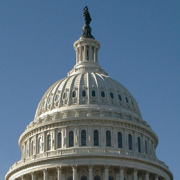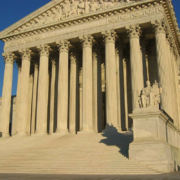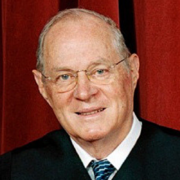Supreme Court vacancy, 2018: An overview
| SCOTUS Vacancy, 2018 |
|---|
| Nominee |
| Retiring Justice |
| Vacancy date |
| Confirmation date |
| Coverage |
|
Timeline |
| See also |
| Brett Kavanaugh Supreme Court vacancy, 2017 Supreme Court of the United States |
Brett Kavanaugh was confirmed as the 114th associate justice of the U.S. Supreme Court by a vote of 50-48-1 on October 6, 2018.
President Donald Trump nominated Kavanaugh to succeed Associate Justice Anthony Kennedy on the U.S. Supreme Court on July 9, 2018.
On September 28, 2018, the Senate Judiciary Committee voted 11-10 along party lines to report Kavanaugh’s nomination to the Senate floor for a vote.[1] The Judiciary Committee had held four days of confirmation hearings from September 4 to 7, 2018, and an additional fifth day of hearings on September 27, 2018, regarding allegations of past sexual misconduct by Kavanaugh which he denied.
Trump said the following regarding Kavanaugh's nomination:
| “ | Judge Kavanaugh has impeccable credentials, unsurpassed qualifications, and a proven commitment to equal justice under the law. A graduate of Yale College and Yale Law school, Judge Kavanaugh currently teaches at Harvard, Yale, and Georgetown. Throughout legal circles, he is considered a judge’s judge, a true thought leader among his peers. He is a brilliant jurist with a clear and effective writing style, universally regarded as one of the finest and sharpest legal minds of our time. And just like justice Gorsuch, he excelled as a clerk for Justice Kennedy.[2][3] | ” |
When Kavanaugh was nominated, he was serving as a federal judge on the U.S. Court of Appeals on the D.C. Circuit. He was appointed by President George W. Bush (R). Prior to his appointment, Kavanaugh served in the Bush administration. He also clerked for Associate Justice Anthony Kennedy and worked for former independent counsel Ken Starr during the investigation of then-President Bill Clinton (D).
Senate Majority Leader Mitch McConnell (R) called Kavanaugh a superb choice who was "extremely well qualified to serve as an Associate Justice of the Supreme Court of the United States."[4]
Senate Minority Leader Chuck Schumer (D) said Kavanaugh received the nomination because "he passed this litmus test, not because he’ll be an impartial judge on behalf of all Americans."[5]
Timeline
The timeline below shows the most noteworthy events in the days leading up to Kavanaugh's confirmation on October 6, 2018. For the full timeline, visit Timeline of events related to the Supreme Court vacancy, 2018.
- October 6, 2018: The Senate voted 50-48-1 to confirm Brett Kavanaugh as the 114th associate justice on the U.S. Supreme Court. Sen. Joe Manchin (D-W.Va.) was the only Democrat to vote to confirm Kavanaugh. Sen. Lisa Murkowski (R-Alaska), who opposed Kavanaugh's nomination, paired her vote with Sen. Steve Daines (R-Mont.), who supported Kavanaugh's nomination, so Daines could attend his daughter's wedding instead of flying back to Washington D.C., for the vote. A simple majority was needed to confirm Kavanaugh. Click here for a breakdown of the Senate vote on Kavanaugh's nomination.
- October 5, 2018: The Senate voted 51-49 to end debate on Brett Kavanaugh’s nomination to the Supreme Court. Sen. Lisa Murkowski (R-Alaska) was the only Republican to vote against advancing Kavanaugh's nomination. Sen. Joe Manchin (D-W.Va.) was the only Democrat to vote to advance the nomination. A cloture vote proposes ending unlimited debate on a nomination. The vote began a 30-hour time limit for final debate before a final confirmation vote. Click here for a breakdown of the Senate vote on cloture.
- October 4, 2018: The Senate Judiciary Committee received the results of the supplemental background investigation on Kavanaugh conducted by the FBI.[6]
- October 3, 2018: Senate Majority Leader Mitch McConnell filed a motion for a cloture vote on Kavanaugh.[7]
- September 28, 2018: The Senate Judiciary Committee voted 11-10 to report Kavanaugh’s nomination to the Senate floor for a vote. Click here for a breakdown of the Senate Judiciary Committee's vote. After the vote, the committee released a statement saying it "will request that the administration instruct the FBI to conduct a supplemental background investigation with respect" to Kavanaugh's nomination. The statement also said that the "supplemental FBI investiagation would be limited to current credible allegations against the nominee and must be completed no later than" October 5, 2018.[8]
- September 27, 2018: Kavanaugh and Blasey Ford testified before the Senate Judiciary Committee.
About Brett Kavanaugh
At the time of his nomination, Brett Kavanaugh was serving as a federal judge on the U.S. Court of Appeals on the D.C. Circuit. He was appointed by President George W. Bush (R) and confirmed in 2006. After Bush was elected president, Kavanaugh was senior associate counsel and associate counsel to the President and then served as assistant to the President and staff secretary. Kavanaugh was serving in this role when Bush nominated him to the D.C. Circuit.
Kavanaugh clerked for Associate Justice Anthony Kennedy from 1993 to 1994. He worked for former independent counsel Ken Starr during the investigation of then-President Bill Clinton (D). He graduated from Yale Law School.
For more information about Kavanaugh, visit Nomination of Brett Kavanaugh to the U.S. Supreme Court.
Major players in Kavanaugh's confirmation
The section below provides details about some of the most influential individuals who played a roll in Brett Kavanaugh's confirmation process.[9]
President Trump: The authority for Presidential nominations is located in the Appointments Clause of the United States Constitution, Article II, Section 2, which reads as follows:
| “ |
and he shall nominate, and by and with the Advice and Consent of the Senate, shall appoint Ambassadors, other public Ministers and Consuls, Judges of the supreme Court, and all other Officers of the United States, whose Appointments are not herein otherwise provided for, and which shall be established by Law... [3] |
” |
Senate Majority Leader Mitch McConnell: As majority leader of the U.S. Senate, McConnell (R-KY) authorized any actions on the Senate floor.
Senate Minority Leader Chuck Schumer: As minority leader of the U.S. Senate, Schumer (D-NY) has said he would try to orchestrate an opposition to Kavanaugh's confirmation.[10]
Jon Kyl: A former senator who spent 18 years on the Senate Judiciary Committee, Kyl was appointed by the White House to guide Kavanaugh through the confirmation process.
Sen. Chuck Grassley: As chair of the Senate Judiciary Committee, Senator Chuck Grassley (R-IA) conducted the process of reviewing and reporting on the nomination.
United States Senate Committee on the Judiciary: The other members of the Senate Judiciary Committee also played a role in Kavanaugh's confirmation process. During the 115th Congress, the Republican members were Chuck Grassley, Orrin Hatch, Lindsey Graham, John Cornyn, Mike Lee, Ted Cruz, Ben Sasse, Jeff Flake, Mike Crapo, Thom Tillis, and John Kennedy. The Democratic members were Dianne Feinstein (ranking member), Patrick Leahy, Richard Durbin, Sheldon Whitehouse, Amy Klobuchar, Cory Booker, Christopher Coons, Richard Blumenthal, Mazie Hirono, and Kamala Harris.
Key senators on Kavanaugh's nomination
Brett Kavanaugh needed a simple majority from a Senate vote to be confirmed to the U.S. Supreme Court. At the time of his confirmation, Republicans had a 51-49 majority in the Senate.[11]
The senators playing a key role in Kavanaugh's confirmation included Susan Collins (R), Joe Donnelly (D), Jeff Flake (R), Heidi Heitkamp (R), Doug Jones (D), Joe Manchin (D), Lisa Murkowski (R), Rand Paul (R), and Chuck Schumer (D). For more information on and reactions from each of them, visit Nomination of Brett Kavanaugh to the U.S. Supreme Court.
Polling
Ballotpedia identified 20 polls released regarding Kavanaugh's nomination. Most reported on results from questions such as whether or not respondents wanted their senators to vote for Kavanaugh's confirmation, or whether or not they thought the judge was qualified to serve on the U.S. Supreme Court. For a list of the polls and their methodologies, visit Nomination of Brett Kavanaugh to the U.S. Supreme Court.
Satellite spending
Millions of dollars were spent during the confirmation process by satellite groups both supporting and opposing Kavanaugh's confirmation. The Judicial Crisis Network led those supporting the confirmation; it spent over $5.3 million on ad buys and a website launch. Leading the groups opposing Kavanaugh's confirmation was Demand Justice, which pledged $10 million mostly for digital ad campaigns.
For a full list of satellite group spending surrounding Kavanaugh's confirmation, visit Nomination of Brett Kavanaugh to the U.S. Supreme Court.
Kavanaugh nomination role in 2018 elections
Brett Kavanaugh's nomination impacted 2018 elections in several ways. All four of the incumbent Democratic senators who lost their re-election bids in 2018 opposed Kavanaugh's nomination. They were Sens. Joe Donnelly (D-Ind.), Heidi Heitkamp (D-N.D.), Claire McCaskill (D-Mo.), and Bill Nelson (D-Fla.).
Ads highlighting the U.S. Supreme Court vacancy also appeared in both general and primary elections, including in Mississippi, Missouri, and Florida. The Republican National Committee (RNC) allocated $250 million to a program supporting Kavanaugh's nomination in ten key states during the elections. And Senate Majority Leader Mitch McConnell (R) threatened to delay the Senate confirmation vote until just before the November general election, which Politico proposed would keep "vulnerable red-state Democrats off the campaign trail while potentially forcing anti-Kavanaugh liberals to swallow a demoralizing defeat just ahead of the midterms." Visit Nomination of Brett Kavanaugh to the U.S. Supreme Court for more.
Process to fill the seat
Although the rules for appointing and confirming a U.S. Supreme Court justice are set out in the U.S. Constitution, the process for choosing nominees is not codified in law. Past presidents have received lists of recommendations from the White House counsel, the attorney general and lawyers in the Justice Department's Office of Legal Counsel. Justices have often been friends or acquaintances who shared ideological views with the president.[12]
The nominating process is also influenced by individuals and organizations outside of the administration. The American Bar Association (ABA), through its 15-member Committee on Federal Judiciary, rates nominees as "well qualified," "qualified" or "not qualified." Others also lobby the president to choose nominees sympathetic to their views or to oppose those with whom they differ.[13]
Presidents have occasionally had what is often called a litmus test or key position that a prospective justice must hold to be considered for nomination. Such a test is typically on an important social issue. But a nominee's views do not always conform to their future opinions. Some justices have ruled in ways that surprised the presidents who nominated them. Notable examples are Justice Tom C. Clark (nominated by President Harry S. Truman), Chief Justice Earl Warren (nominated by President Dwight D. Eisenhower) and Justice David Souter (nominated by President George H. W. Bush).[14]
For a step-by-step breakdown of the process from nomination to confirmation as well as historical context, visit Nomination of Brett Kavanaugh to the U.S. Supreme Court.
See also
- Nomination of Brett Kavanaugh to the U.S. Supreme Court
- Brett Kavanaugh confirmation hearings
- Supreme Court vacancy, 2018: An overview
- Timeline of events related to the Supreme Court vacancy, 2018
- Process to fill the vacated seat of Justice Anthony Kennedy
- Supreme Court of the United States
- History of the Supreme Court
- Supreme Court cases, October term 2017-2018
Footnotes
- ↑ The Hill, "Judiciary panel approves Kavanaugh, sending nomination to full Senate," September 28, 2018
- ↑ C-SPAN, "Judge Brett Kavanaugh Supreme Court Nomination Announcement," July 9, 2018
- ↑ 3.0 3.1 Note: This text is quoted verbatim from the original source. Any inconsistencies are attributable to the original source.
- ↑ CNN, "Trump nominates Brett Kavanaugh for Supreme Court," July 9, 2018
- ↑ Twitter, "Chuck Schumer on Twitter," July 9, 2018
- ↑ Senate Judiciary Committee, "Senate Judiciary Committee Receives Supplemental Background Investigation File on Kavanaugh Nomination," October 4, 2018
- ↑ CBS News, "McConnell sets key cloture vote on Kavanaugh confirmation for Friday," Updated October 4, 2018
- ↑ United States Senate Committee on the Judiciary, "Statement from the Senate Judiciary Committee," September 28, 2018
- ↑ National Archives and Records Administration, "Constitution of the United States," accessed February 18, 2016
- ↑ Politico, "Schumer lays out path to block Kavanaugh," July 10, 2018
- ↑ New York Magazine, "Rand Paul Is Pretending That He Might Not Vote for Brett Kavanaugh," July 23, 2018
- ↑ NBC News, "A guide to the Supreme Court nomination," accessed February 13, 2016
- ↑ CQ Press, "The Selection and Confirmation of Justices: Criteria and Process," accessed February 13, 2016
- ↑ New York Times, "Presidents, Picking Justices, Can Have Backfires," July 5, 2005
| |||||||||||
















